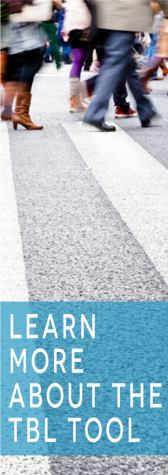 V.1
V.1




The TRIPLE BOTTOM LINE TOOL is designed to help optimize and communicate the impact of economic development investment on economic vitality, natural resource stewardship, and community well-being. Click below to get quick facts, or download the User's Guide to dig into details.
The triple bottom line (TBL) concept originated in the business sector as a way to capture important investment value that is not reflected in conventional balance sheets. The concept – also referred to as people, planet, profit – aims to better account for environmental, social, and economic value of investment so that resources are more efficiently and effectively employed.
In economic development, traditional measures such as jobs created and dollars leveraged are important, but do not provide a complete view of investment impact. Triple bottom line economic development considers a broader array of economic, environmental, and social factors. We define triple bottom line economic development as programs, policies, or activities that create or retain jobs and wealth in ways that contribute to individual and community well-being over time. This type of economic development is distinct from economic growth, which may or may not promote community goals such as quality of life, access and opportunity, environmental stewardship, and fiscal health.
It is important to note that economic, environmental, and social dimensions of the triple bottom line are interrelated. For example, investments in green building may result in energy cost savings (economic), increased building value (economic), higher occupant satisfaction and productivity (economic and social), and lower natural resource and human health impacts (environmental, social, and economic). Ideally, a triple bottom line approach can provide a way to consider these connections and configure investments for strong performance.
The Triple Bottom Line Tool (TBL Tool) is designed to serve investors, economic development professionals, and decision-makers in the private, public, and non-profit sectors. The TBL Tool can be applied in a number of ways. As a design tool, you can configure development investments for strong results. As a decision tool, you can winnow, compare, or rank projects. As a communication tool, you can describe how an investment aligns with TBL goals and community priorities. As an educational tool, the documentation and case illustrations can help build understanding about economic development processes and impacts.
The TBL Tool can be used to review and improve a proposed project, prepare bid documents, or communicate with stakeholders. It can be used to compare one project on multiple sites, multiple projects on one site, or many different projects. Whatever the application, the TBL Tool supports strategic investment that contributes to quality of life and sustainability.
Development of the TBL Tool was led by Dr. Janet Hammer from Portland State University, in collaboration with Maggie McCullough from PolicyMap, Dr. Gary Pivo from the University of Arizona, and Dr. Ira Goldstein from The Reinvestment Fund. Dr. Hammer has more than twenty years experience working in private, public, and non-profit settings to help create high performance communities, and currently serves as director of Portland State University's Initiative on Triple Bottom Line Development. Ms. McCullough is the director of PolicyMap, an award-winning on-line platform whose value is captured in their tag line – "Good Data, Smart Decisions." Dr. Goldstein has decades of experience analyzing neighborhood investment strategies and serves as Director of Policy Solutions at The Reinvestment Fund – one of the country's oldest and most successful Community Development Financial Institutions. Dr. Pivo has an extensive record of research, consulting and public service, including developing industry-responsive triple bottom line metrics for the built environment and serving as Co-Director of the Responsible Property Investing Center.
Practitioners have provided input throughout the development process in order to ensure that the TBL Tool is relevant and user-friendly. This includes input from a survey of nearly 400 economic development professionals as well as focus groups with members of the International Economic Development Council (IEDC) and the National Association of Development Organizations (NADO). During key phases of the TBL Tool development, input was provided by a group of national advisors representing diversity of geography, area of expertise, and type of jurisdiction. You can learn more about our national advisors and input process in the TBL Tool User's Guide. We are grateful to the hundreds of people who have provided input to the TBL Tool development.
The process for developing the TBL Tool has been rigorous, inclusive, transparent, and pragmatic. The TBL Tool is informed by community priorities, current research, leading edge practice, and practitioner input. This effort included the following:
- Thirty-one comprehensive community indicator programs from a range of urban and rural settings were analyzed to ensure that measures support common priorities defined at city, county, regional, and state levels across the U.S.
- Twenty-one existing TBL assessment tools were reviewed to ensure consistency with approaches used in related areas of development, real estate, infrastructure, business, and investment.
- An extensive literature review was conducted to ensure that measures are consistent with relevant research.
Synthesizing these findings, we identified areas of convergence and defined performance areas and measures to support the triple bottom line goals of economic vitality, natural resource stewardship, and community well-being. Working with our national advisors and topic experts we then identified appropriate data sources to operationalize the measures. In developing measures, availability and quality of data was considered, as well as responsiveness to the unique features of particular communities and projects. Further, to ensure that the TBL Tool is relevant and user-friendly, there have been many points of feedback with end users including interviews, focus groups, a national survey of economic development professionals, and usability testing. Details about the TBL Tool development process and measures can be found in the TBL Tool User's Guide.
The TBL Tool considers how well a project seems to align with triple bottom line goals of economic vitality, natural resource stewardship, and community well-being. The TBL Tool uses a type of scoring called multi-criteria decision analysis – a procedure that allows items of interest that are measured in different ways to be considered together. For example, imagine you would like to select a product based on purchase price, maintenance costs, user interface, and environmental impact. Each of these criteria is measured in different ways: multi-criteria decision analysis provides a way to sum up these "apples and oranges."
The TBL Tool generates a score for each of the three triple bottom line goals: economic vitality, natural resource stewardship, and community well-being. Each goal is comprised of performance areas (outcomes that help us achieve our goal), and each performance area is comprised of measures (items that help deliver those outcomes). The score for a goal is computed by taking the average of its performance area scores, and each performance area score is computed by taking the average of its measure scores. Measures were selected based on their contribution to the concept of triple bottom line economic development and availability of data. Scores are based on a scale of 0 - 100, indicating the investment's degree of alignment or accomplishment. The tool does not explicitly weight measures; however, implicit weighting occurs because the relative weight of each measure varies depending upon how many measures are grouped in a performance area (e.g., a measure carries more "weight" if a performance area score is the average of three measures rather than ten measures). Users may wish to look more deeply at measures that are particularly important to their community or context.
In order to account for contextual issues such as differences in project type, size, location, and community characteristics a measure score may appear as NA, FYI or bonus: NA scores ensure that overall scores are not affected if data is unavailable or a measure is not relevant (e.g., affordable housing questions are not applied to a manufacturing facility that has no housing component); FYI scores present summary information that may be useful to reviewers but is not linked to project impact (e.g., leveraged dollars); bonus scores provide credit for specific areas of leadership. Detailed information about measures and scoring can be found in the TBL Tool User's Guide.
The TBL Tool generates a project report that includes both the project information and the project scores. This is helpful both for confirming that information was accurately entered and for considering potential areas for improvement. The TBL Tool also generates a "Due Diligence" report that provides a list of items that have been identified as completed, due to be completed, or warranting further attention.
When reviewing project reports it is important to keep in mind that scores speak to a project's alignment with TBL goals. Scores provide a general indication of how well a project aligns with TBL goals; two projects with the same score may differ in the type or magnitude of impact.
National advisors representing diversity of geography, expertise, and organizational size and type provided detailed input and review of the measures during development of the TBL Tool. The TBL Tool was pilot-tested to assess functionality (e.g., correct calculations, ease of navigation). The beta test phase for the TBL Tool ran from August 30, 2012 to May 31, 2013. Users represented diverse geographies, organization types, and levels of management. Feedback on the beta version of the TBL Tool was collected via a user-friendly on-line survey, as well as through more extensive testing and collaborative discussion with testing partners. Overall, users found that the tool provides meaningful information and is easy to use. We expect to continue improving the by responding to changes in data availability and user needs. We invite you to provide your feedback through our brief survey or by emailing us at info(at)www.tbltool.org.
A list of project information that you will need to complete the TBL Tool can be found here. You may find it helpful to print a copy of the data document to facilitate your process of collecting and entering data into the tool.
We suggest that you start with our brief orientation video. You will also want to collect your project information and may want to keep the User's Guide on hand. When you are ready to enter information for a project you will create an account by defining a user name and password. You will use this account to store information for all projects that you are scoring. You will use this user name and password any time that you log on to your account and work with project information. Information on saving and retrieving project information is in the FAQs below.
Your work is saved as you proceed through the TBL Tool. If you change the response to a question for a project, that information will be saved and the project scores and report will recalibrate. To compare different versions of a project (answers and scores), you must create two separately named versions of the project.
Project scores for the TBL goals and performance areas are only generated when all project information has been entered. If information is incomplete, the tool will generate a working document or partial report that lists the information entered thus far and scores for the corresponding measures.
If your browser is left open but unused for a while your session will "time out." You should be able to continue by logging out and then logging back in.
To open an existing project simply proceed to the Calculate Your TBL section of the TBL Tool, select the project of interest from the pull-down menu on the Specify Location section of the navigation bar. The project will open and you can now move through the tool by clicking on the navigation bar and scrolling to the section(s) of interest. Your work is saved as you proceed through the tool. To compare different versions of a project (answers and scores), you must create two separately named versions of the project. To do this you will need to create a new version of the project by clicking on the "save as" button. Creating another (comparison) version of a project is not the same as renaming a project.
To compare different versions of a project (answers and scores), you must create two separately named versions of the project. To do this you will open an existing project by proceeding to the Calculate Your TBL section of the TBL Tool and selecting the project of interest from the pull-down menu on the Specify Location section of the navigation bar. You will then create a new version of the project by clicking on the "save as" button. You may now proceed through the tool, making the desired changes. Your work is saved as you proceed through the tool and a separate project report will be generated for the new version of the project.
Once a project file is open you may rename or delete the project by clicking on the corresponding button.
To access the PDF version of a project report proceed to the Calculate Your TBL section of the tool, select the project of interest from the dropdown menu on the Specify Location section of the navigation bar, and then click on the PDF icon to the right of the project name.
To access the online version of a project report proceed to the Calculate Your TBL section of the tool, select the project of interest from the dropdown menu on the Specify Location section of the navigation bar, and then click Generate TBL or Access TBL Report.
The beta version of the TBL Tool was available from August 2012 until January 2014. The nature of some of the enhancements to Version 1 (e.g., new questions, scoring, comparison features) preclude direct migration of data from the beta version to Version 1. Future version upgrades are not expected to require re-entry of data.
You may need to upgrade your browser or download a free browser in order to have the optimal experience with the TBL Tool. The TBL Tool works on Mozilla Firefox, Google Chrome, and Internet Explorer 8 and above. Please contact your administrator to upgrade your version of Internet Explorer or download Mozilla Firefox or Google Chrome if you are running an unsupported browser.
You can send questions or comments to info[at]www.tbltool.org. We also welcome your feedback via our brief on-line survey.
We continue to keep our eye on upgrades and enhancements. Strong interest has been expressed in creating a version that can be applied to economic development investments that do not have a specific location or address (e.g., a citywide conservation program). There is also interest in developing site content that provides information on "how to" and best practice, as well as in version that can be used outside of the U.S. Your feedback and suggestions are welcome.
